Determination of Calorific Value of Mixed Coals by Analysis of Major Elements Using Data Pre-Processing in Laser-Induced Breakdown Spectroscopy
Abstract
1. Introduction
2. Materials and Methods
3. Results and Discussion
3.1. Mixed Coal Major Elements Analysis
3.1.1. Partial Least Squares Regression (PLSR) of Major Elements of Mixed Coal
3.1.2. Root Mean Square Error (RMSE) Average of Major Elements of Mixed Coals
3.1.3. Residual Predictive Deviation (RPD) of Major Elements of Mixed Coals
3.2. Calorific Value Analysis
4. Conclusions
Author Contributions
Funding
Conflicts of Interest
References
- Korea Energy Economics Institute. Yearbook of Energy Statics; Korea Energy Economics Institute: Ulsan, Republic of Korea, 2017; pp. 180–181. [Google Scholar]
- Wang, Z.; Dong, F.; Zhou, W. A rising force for the world-wide development of laser-induced breakdown spectroscopy. Plasma Sci. Technol. 2015, 8, 617–620. [Google Scholar] [CrossRef]
- Wilde, H.R.; Herzog, W. On-line analysis of coal by neutron induced gamma spectrometry. J. Radioanal. Chem. 1982, 71, 253–264. [Google Scholar] [CrossRef]
- Zhang, Y.S.; Lee, J.T.; Hwang, S.W.; Jin, Y.I.; Park, C.W.; Moon, Y.H. Quantitative Elemental Analysis in Soils by using Laser Induced Breakdown Spectroscopy(LIBS). Korean J. Soil Sci. Fertil. 2009, 42, 399–407. [Google Scholar]
- Fichet, P.; Mauchien, P.; Wagner, J.F.; Moulin, C. Quantitative elemental determination in water and oil by laser induced breakdown spectroscopy. Anal. Chim. Acta 2001, 429, 269–278. [Google Scholar] [CrossRef]
- Davari, S.A.; Hu, S.; Pamu, R.; Mukherjee, D. Calibration-free quantitative analysis of thin-film oxide layers in semiconductors using laser induced breakdown spectroscopy (LIBS). J. Anal. At. Spectrom. 2017, 32, 1378–1387. [Google Scholar] [CrossRef]
- Yao, S.; Lu, J.; Dong, M.; Chen, K.; Li, J.; Li, J. Extracting coal ash content from laser-induced breakdown spectroscopy (LIBS) spectra by multivariate analysis. Appl. Spectrosc. 2011, 65, 1197–1201. [Google Scholar] [CrossRef] [PubMed]
- Yuan, T.; Wang, Z.; Lui, S.L.; Fu, Y.; Li, Z.; Liu, J.; Ni, W. Coal property analysis using laser-induced breakdown spectroscopy. J. Anal. At. Spectrom. 2013, 28, 1045–1053. [Google Scholar] [CrossRef]
- Dong, M.; Lu, J.; Yao, S.; Li, J.; Li, J.; Zhong, Z.; Lu, W. Application of LIBS for direct determination of volatile matter content in coal. J. Anal. At. Spectrom. 2011, 26, 2183–2188. [Google Scholar] [CrossRef]
- Liangying, Y.; Jidong, L.; Wen, C.; Ge, W.; Kai, S.; Wei, F. Analysis of Pulverized Coal by Laser-Induced Breakdown Spectroscopy. Plasma Sci. Technol. 2005, 7, 3041–3044. [Google Scholar] [CrossRef]
- Wang, Z.; Yuan, T.B.; Lui, S.L.; Hou, Z.Y.; Li, X.W.; Li, Z.; Ni, W.D. Major elements analysis in bituminous coals under different ambient gases by laser-induced breakdown spectroscopy with PLS modeling. Front. Phys. 2012, 7, 708–713. [Google Scholar] [CrossRef]
- Pei, L.; Jiang, G.; Tyler, B.J.; Baxter, L.L.; Linford, M.R. Time-of-flight secondary ion mass spectrometry of a range of coal samples: A chemometrics (PCA, cluster, and PLS) analysis. Energy Fuels 2008, 22, 1059–1072. [Google Scholar] [CrossRef]
- Bona, M.T.; Andrés, J.M. Reflection and transmission mid-infrared spectroscopy for rapid determination of coal properties by multivariate analysis. Talanta 2008, 74, 998–1007. [Google Scholar] [CrossRef] [PubMed]
- Wang, Y.; Yang, M.; Wei, G.; Hu, R.; Luo, Z.; Li, G. Improved PLS regression based on SVM classification for rapid analysis of coal properties by near-infrared reflectance spectroscopy. Sens. Actuators B Chem. 2014, 193, 723–729. [Google Scholar] [CrossRef]
- Li, W.; Lu, J.; Dong, M.; Lu, S.; Yu, J.; Li, S.; Huang, J.; Liu, J. Quantitative Analysis of Calorific Value of Coal Based on Spectral Preprocessing by Laser-Induced Breakdown Spectroscopy (LIBS). Energy Fuels 2018, 32, 24–32. [Google Scholar] [CrossRef]
- Lee, Y.; Choi, D.; Gong, Y.; Nam, S.-H.; Nah, C. Laser-induced plasma emission spectra of halogens in the helium gas flow and pulsed jet. Anal. Sci. Technol. 2013, 26, 235–244. [Google Scholar] [CrossRef]
- Galtier, O.; Abbas, O.; Le Dréau, Y.; Rebufa, C.; Kister, J.; Artaud, J.; Dupuy, N. Comparison of PLS1-DA, PLS2-DA and SIMCA for classification by origin of crude petroleum oils by MIR and virgin olive oils by NIR for different spectral regions. Vib. Spectrosc. 2011, 55, 132–140. [Google Scholar] [CrossRef]
- Martelo-Vidal, M.J.; Vázquez, M. Determination of polyphenolic compounds of red wines by UV–VIS–NIR spectroscopy and chemometrics tools. Food Chem. 2014, 158, 28–34. [Google Scholar] [CrossRef]
- Aleixandre-Tudó, J.L.; Alvarez, I.; García, M.J.; Lizama, V.; Aleixandre, J.L. Application of multivariate regression methods to predict sensory quality of red wines. Food Sci. 2015, 33, 217–227. [Google Scholar] [CrossRef]
- Wu, Z.; Xu, E.; Long, J.; Zhang, Y.; Wang, F.; Xu, X.; Jin, Z.; Jiao, A. Monitoring of fermentation process parameters of Chinese rice wine using attenuated total reflectance mid-infrared spectroscopy. Food Control 2015, 50, 405–412. [Google Scholar] [CrossRef]
- Kathiravale, S.; Yunus, M.N.M.; Sopian, K.; Samsuddin, A.H.; Rahman, R.A. Modeling the heating value of Municipal Solid Waste. Fuel 2003, 82, 1119–1125. [Google Scholar] [CrossRef]
- Sanghapi, H.K.; Jain, J.; Bol’Shakov, A.; Lopano, C.; McIntyre, D.; Russo, R. Determination of elemental composition of shale rocks by laser induced breakdown spectroscopy. Spectrochim. Acta-Part B At. Spectrosc. 2016, 122, 9–14. [Google Scholar] [CrossRef]
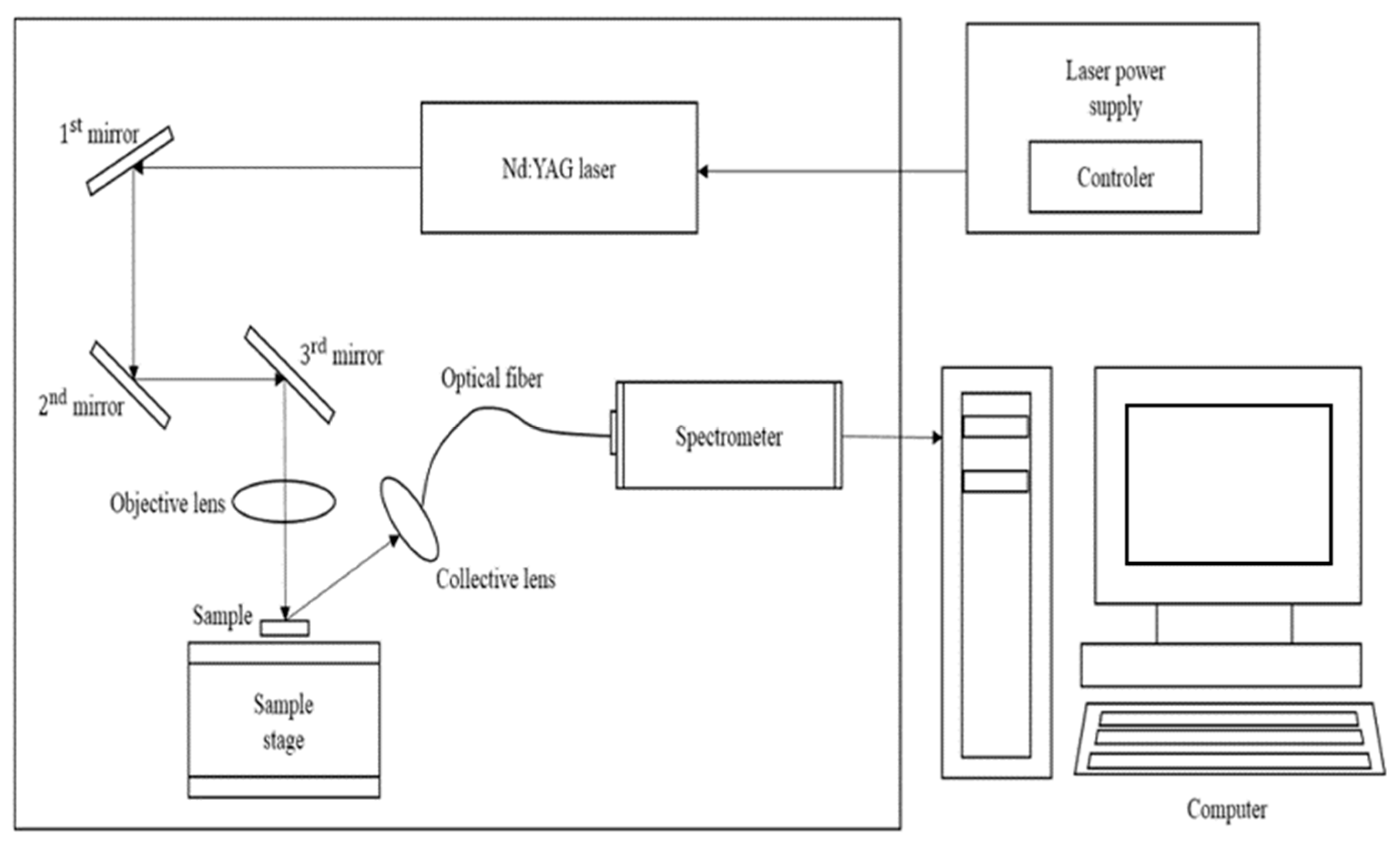
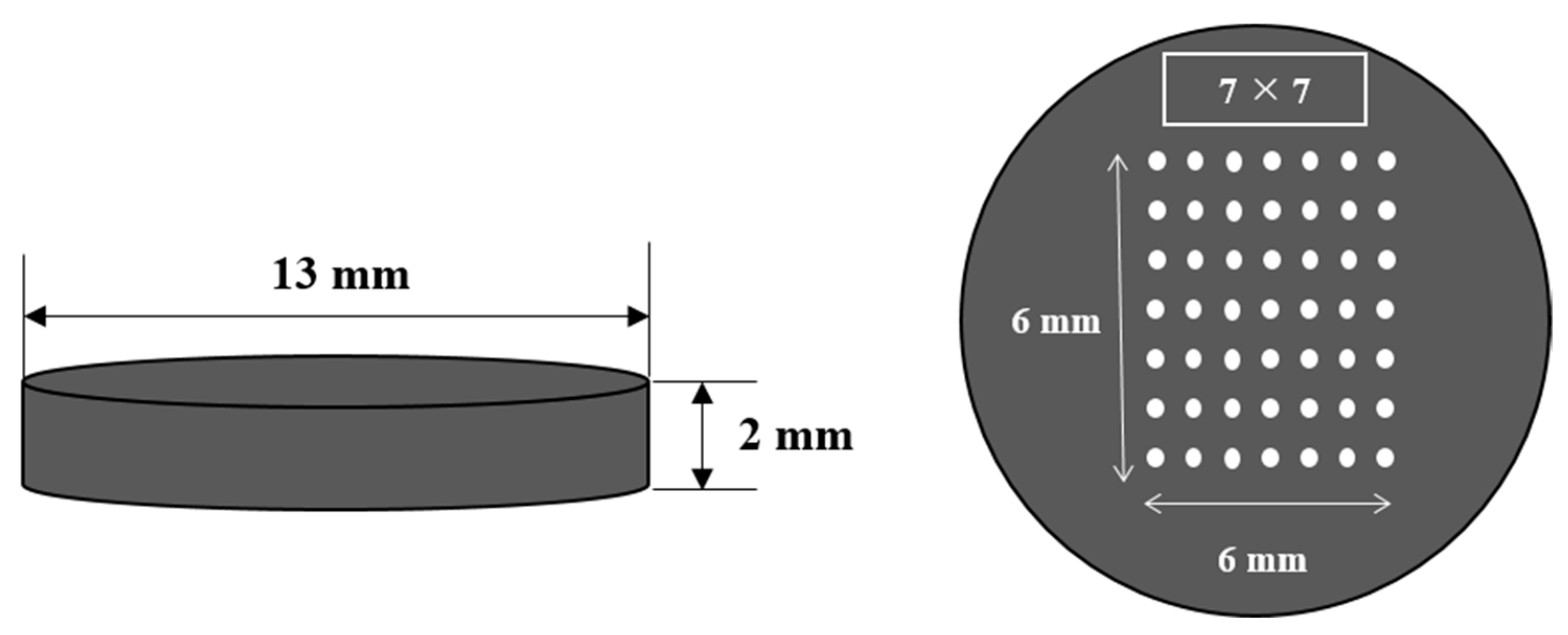
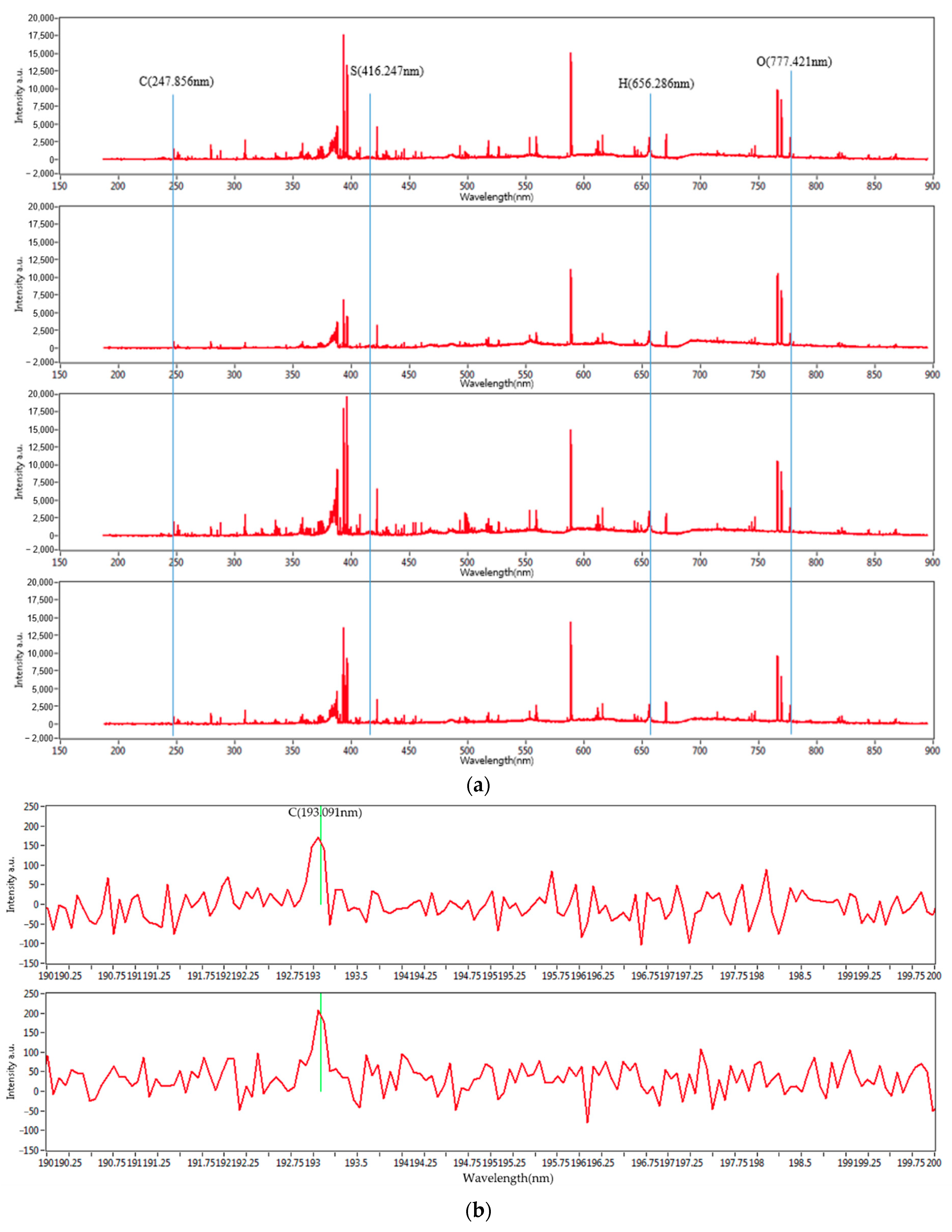
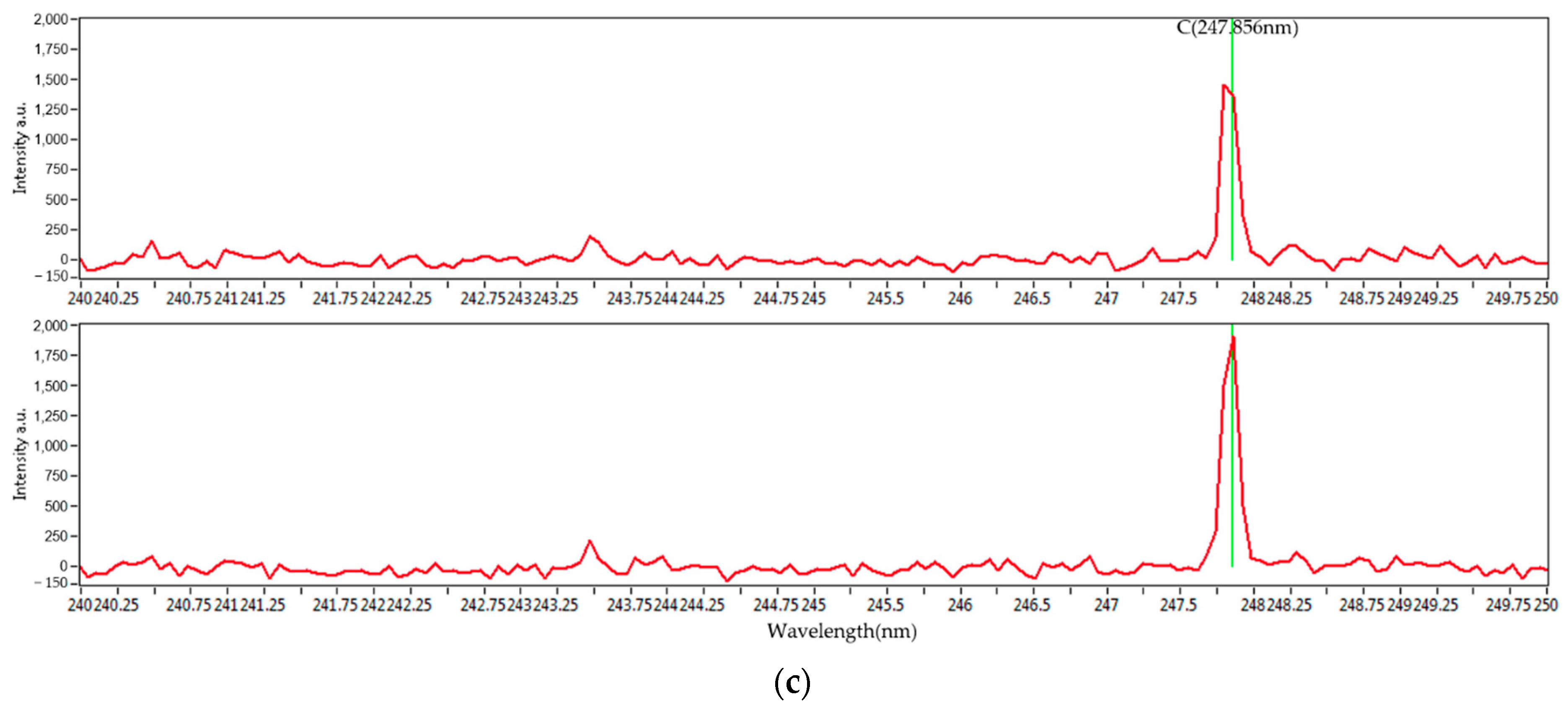
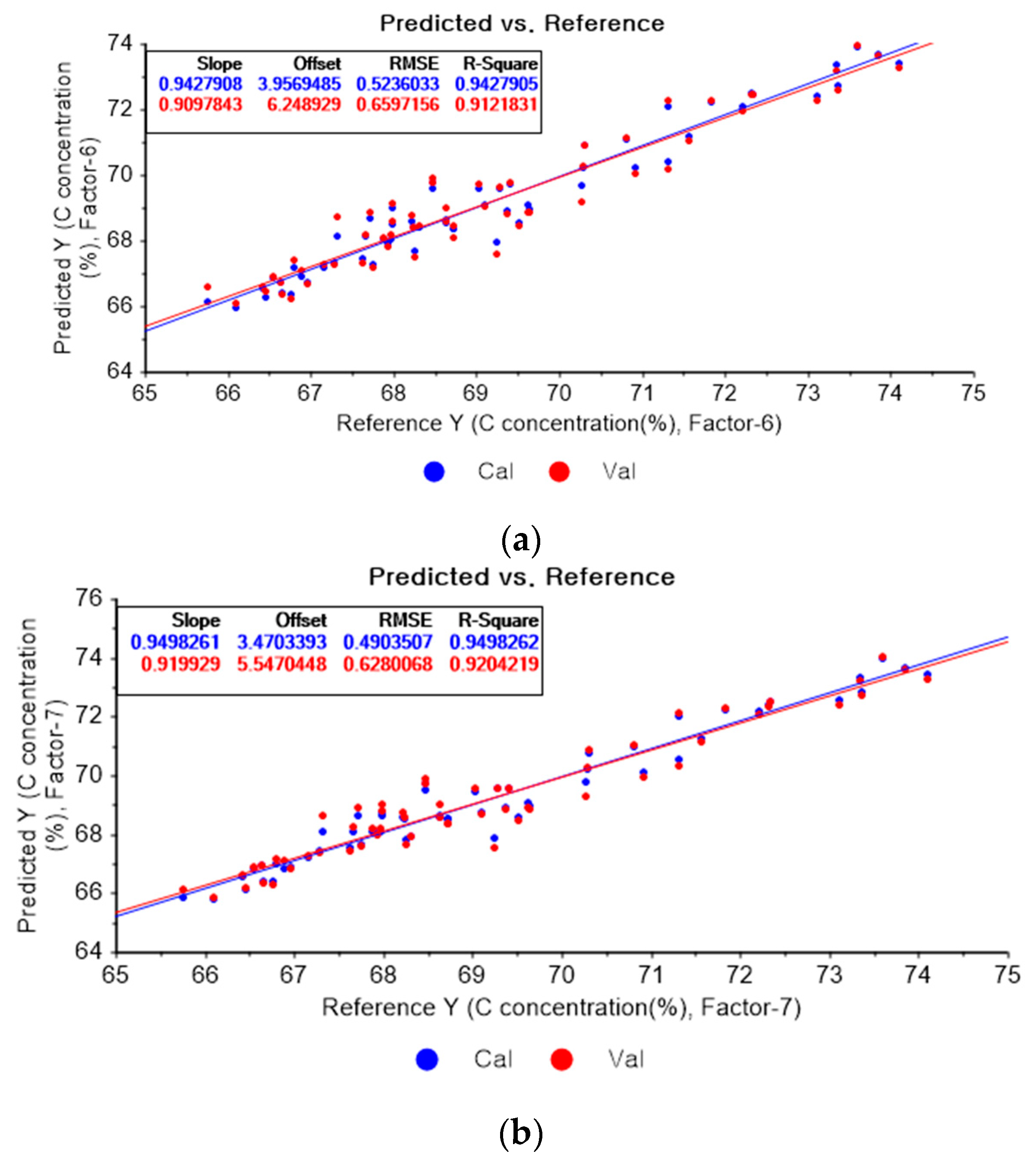

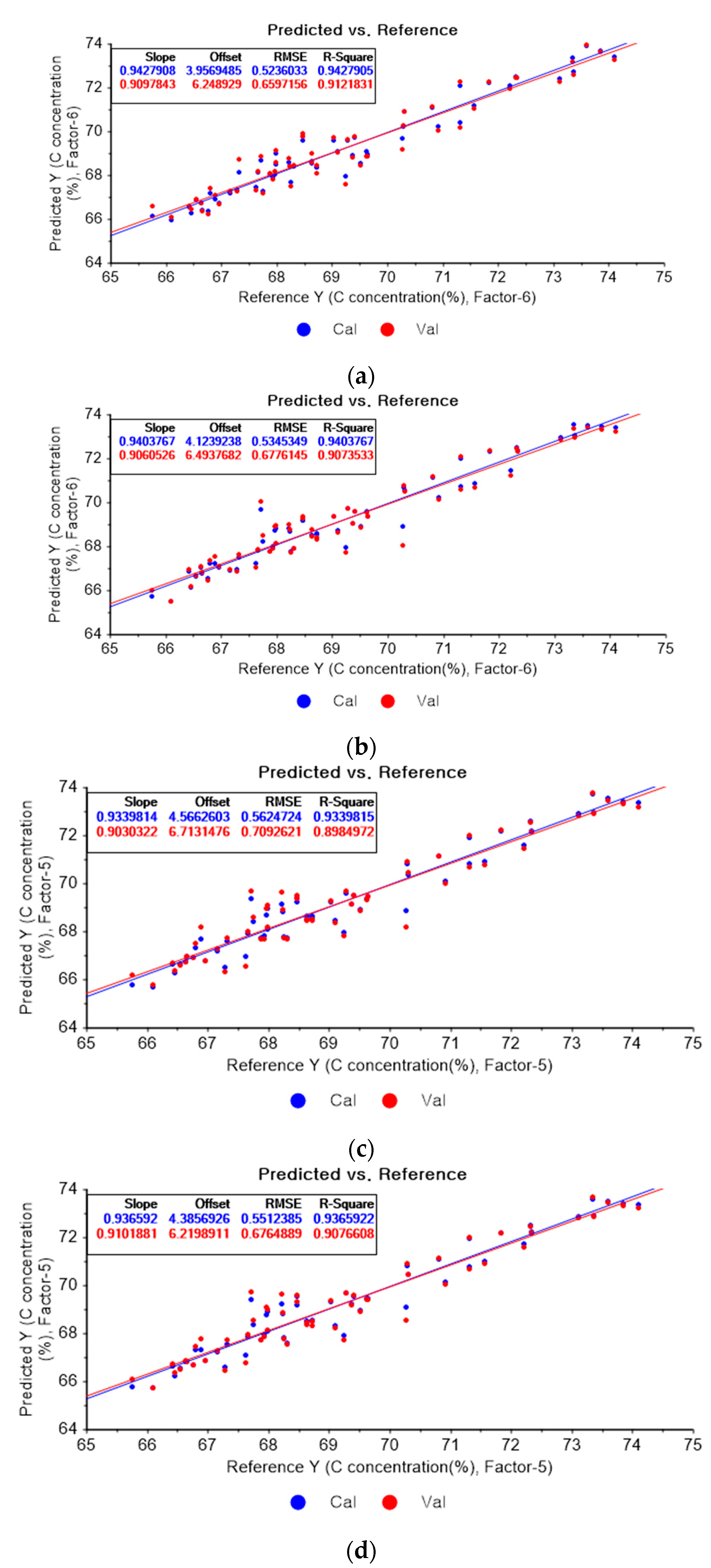

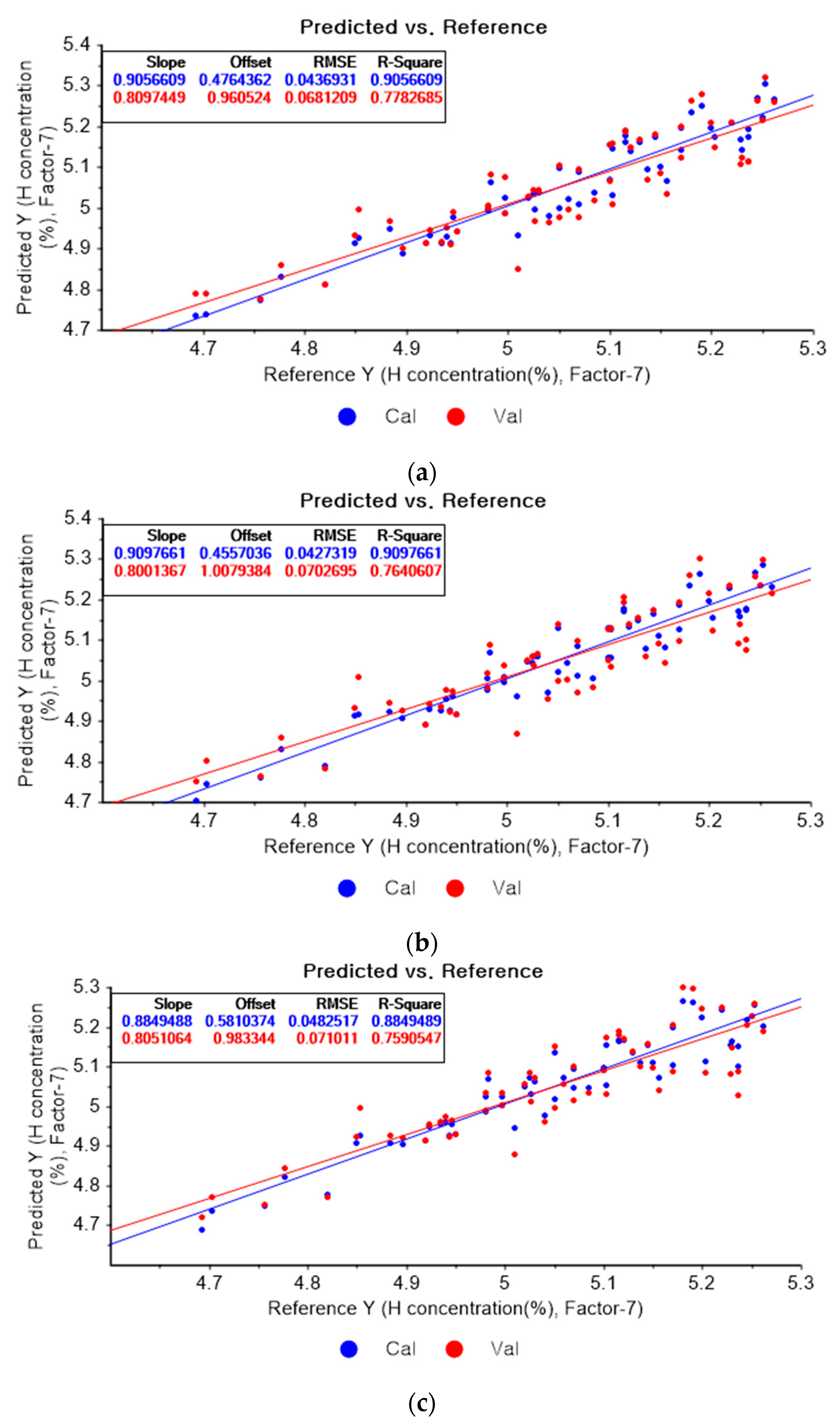
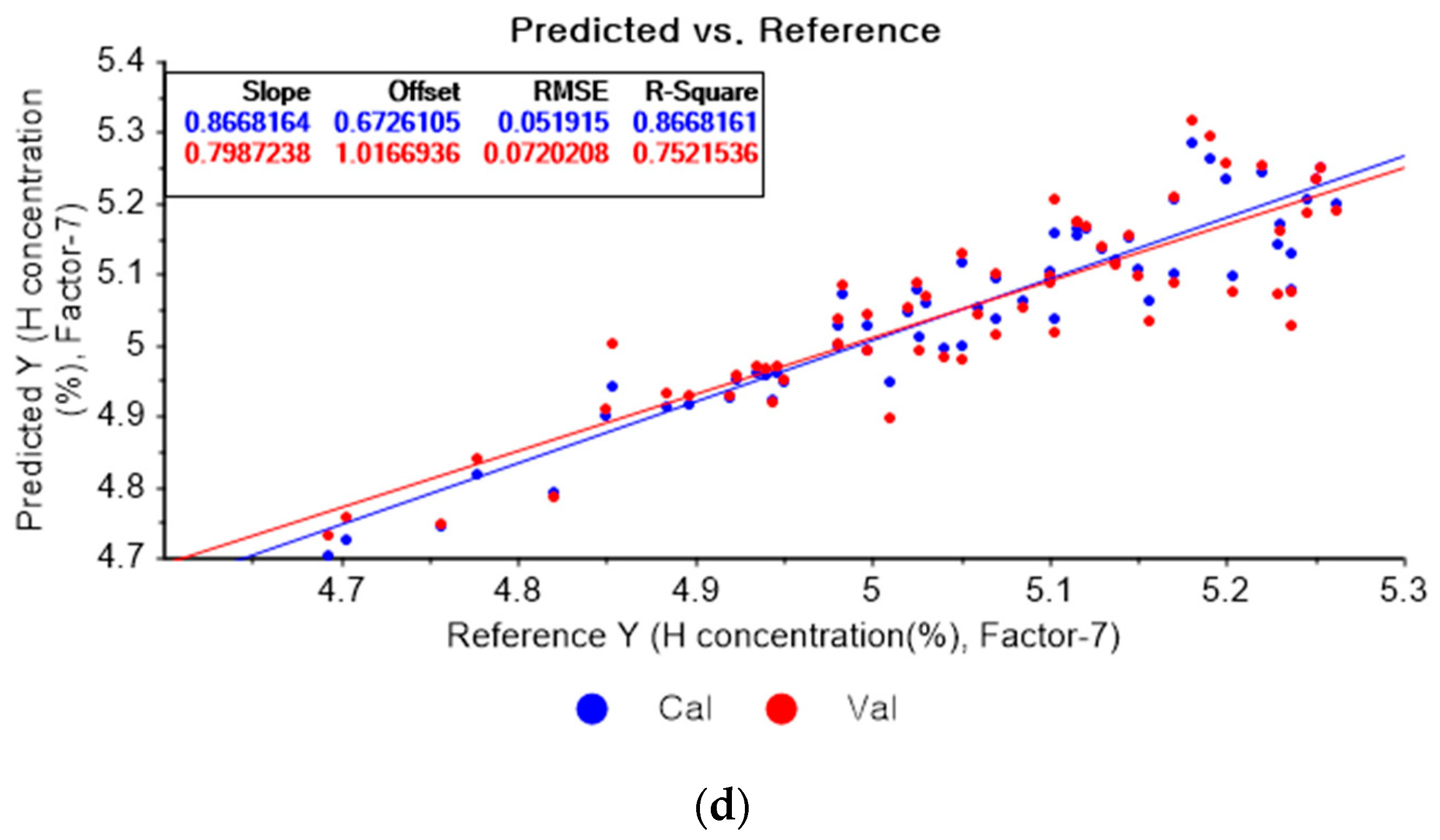
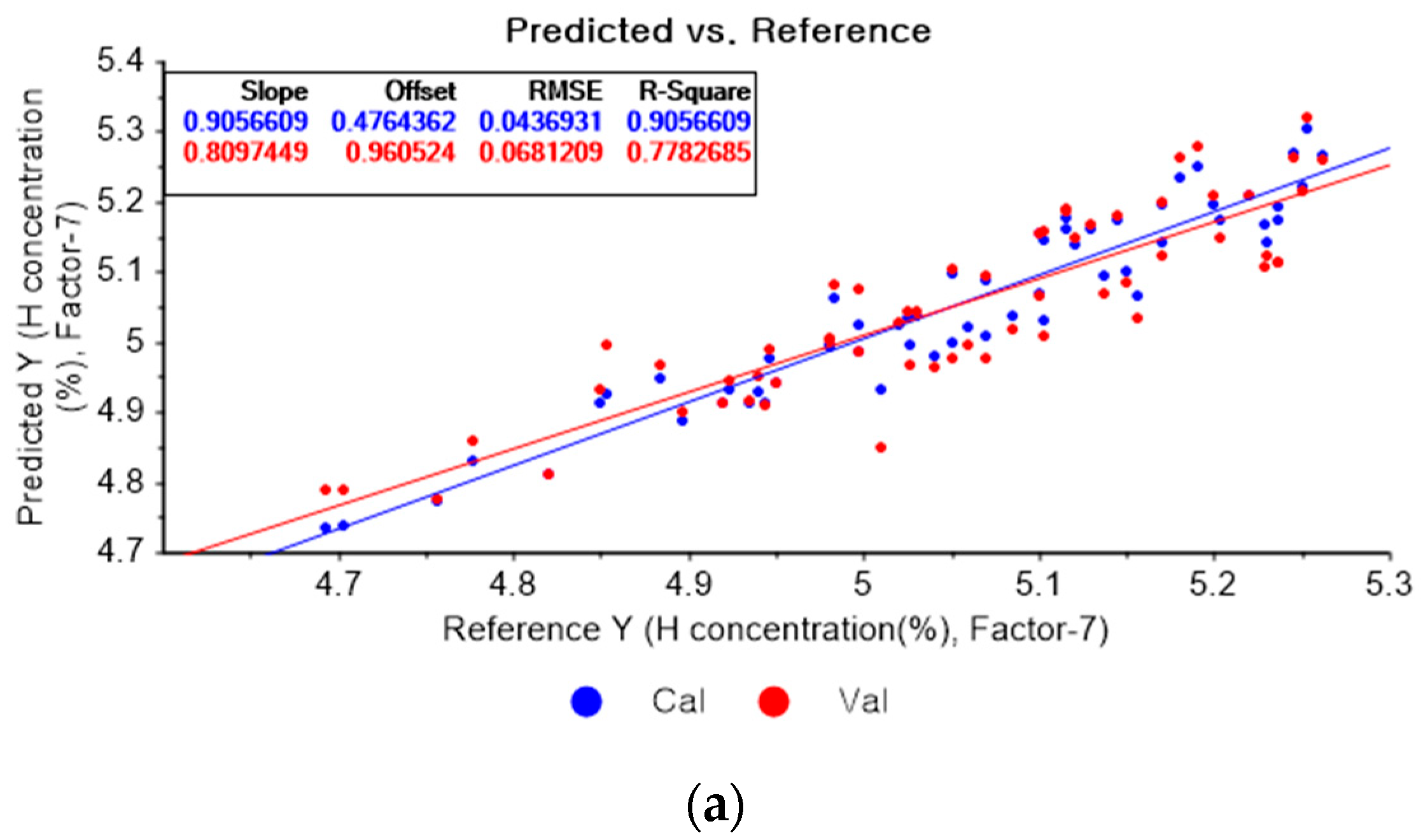
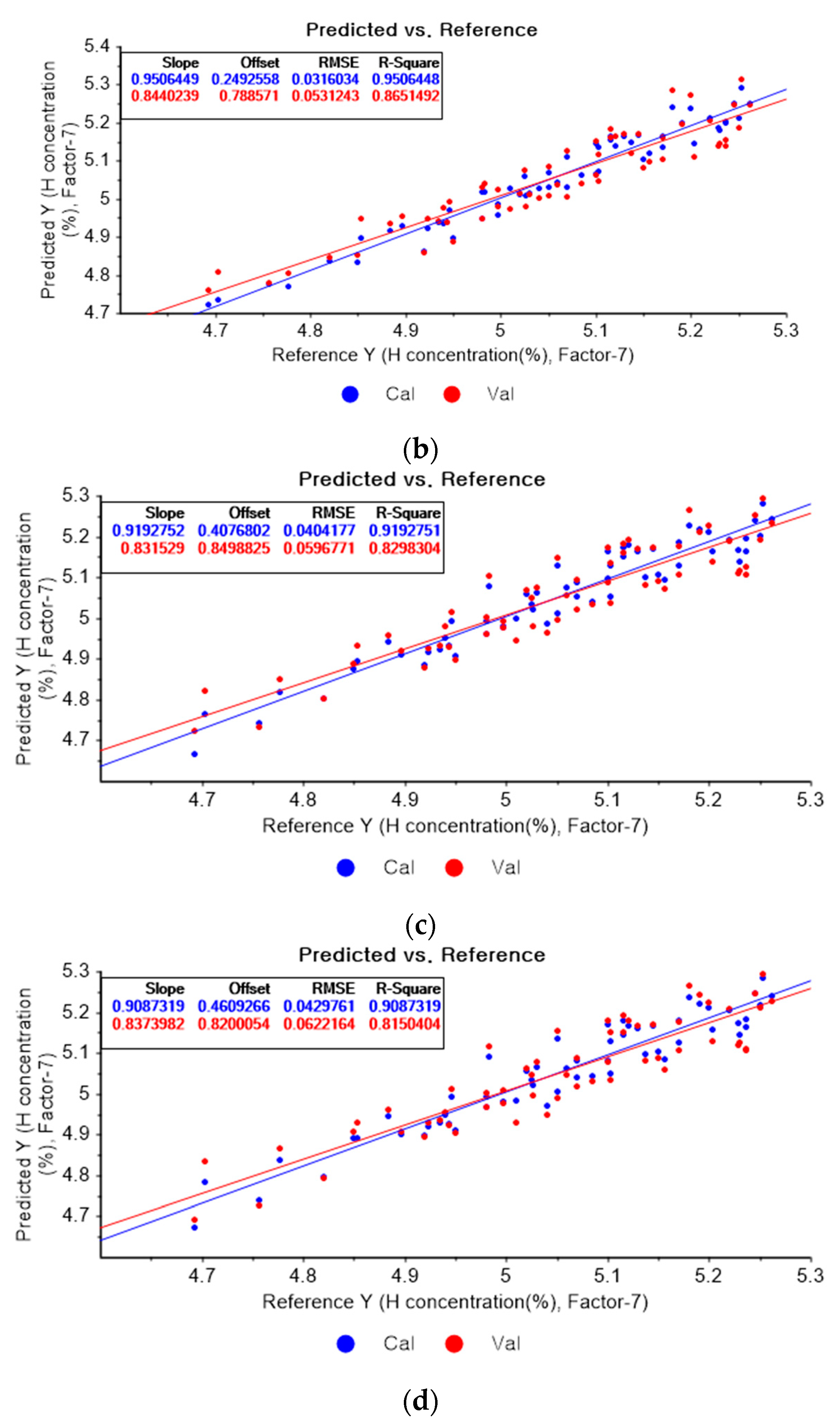
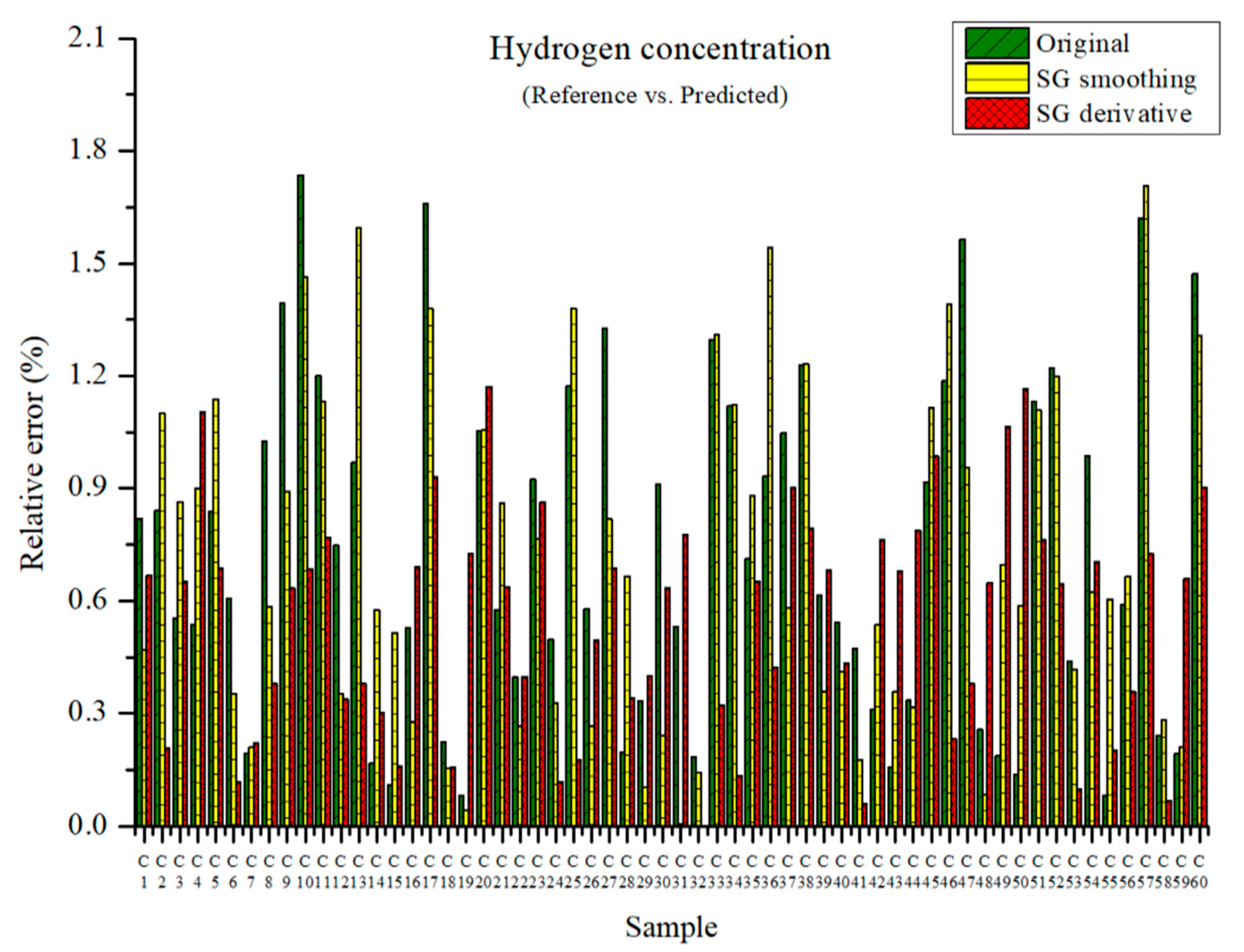

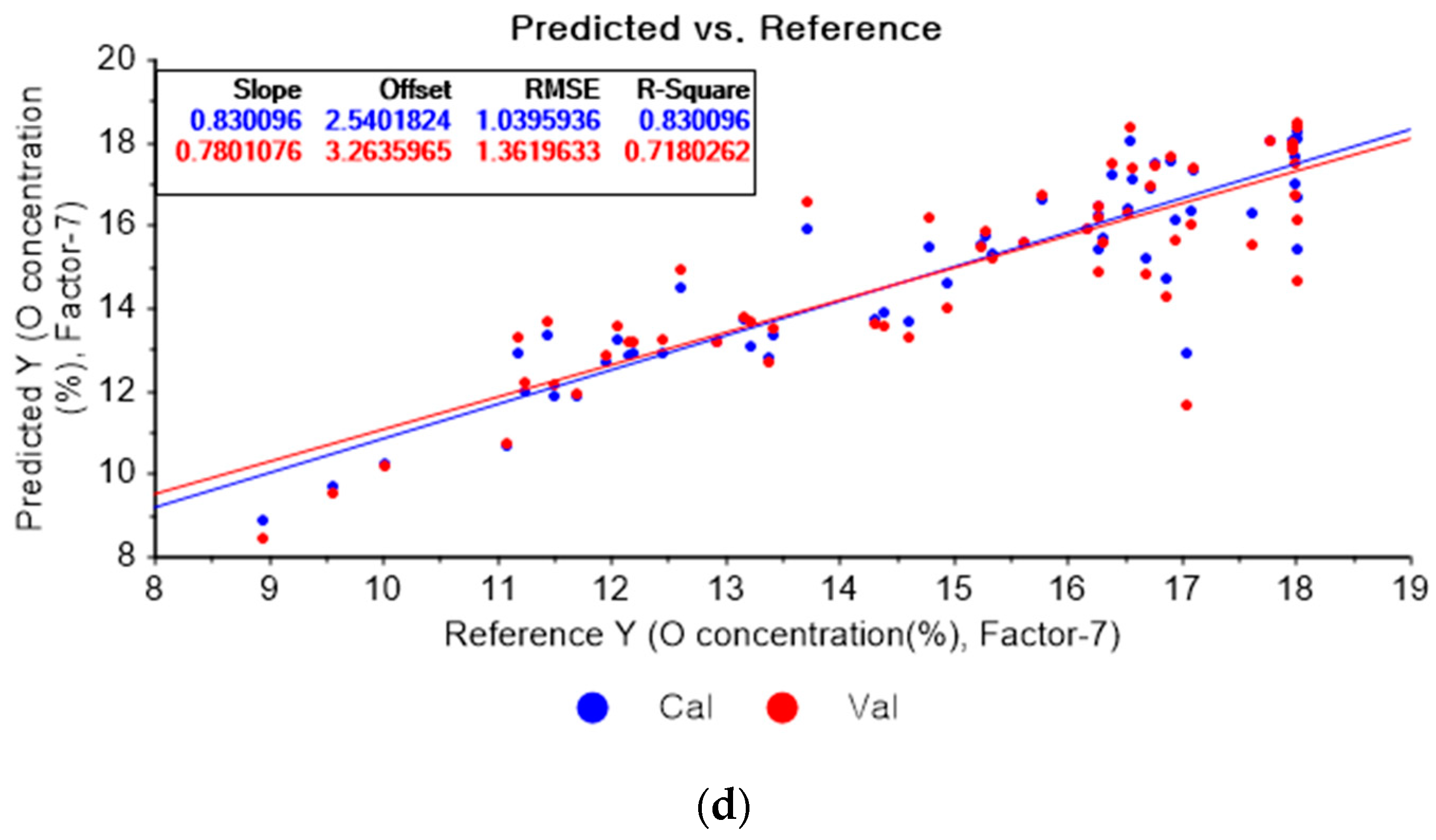
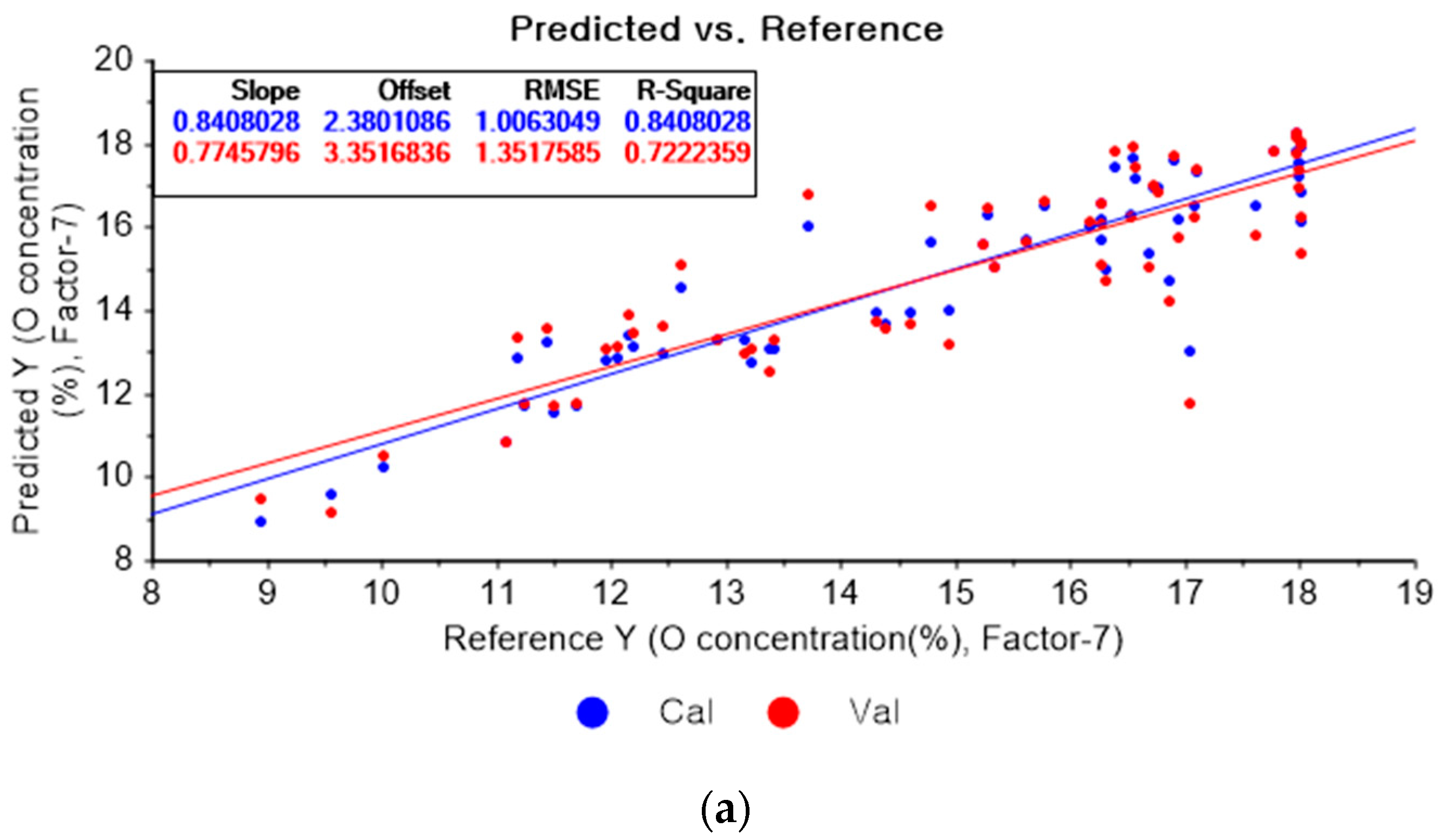
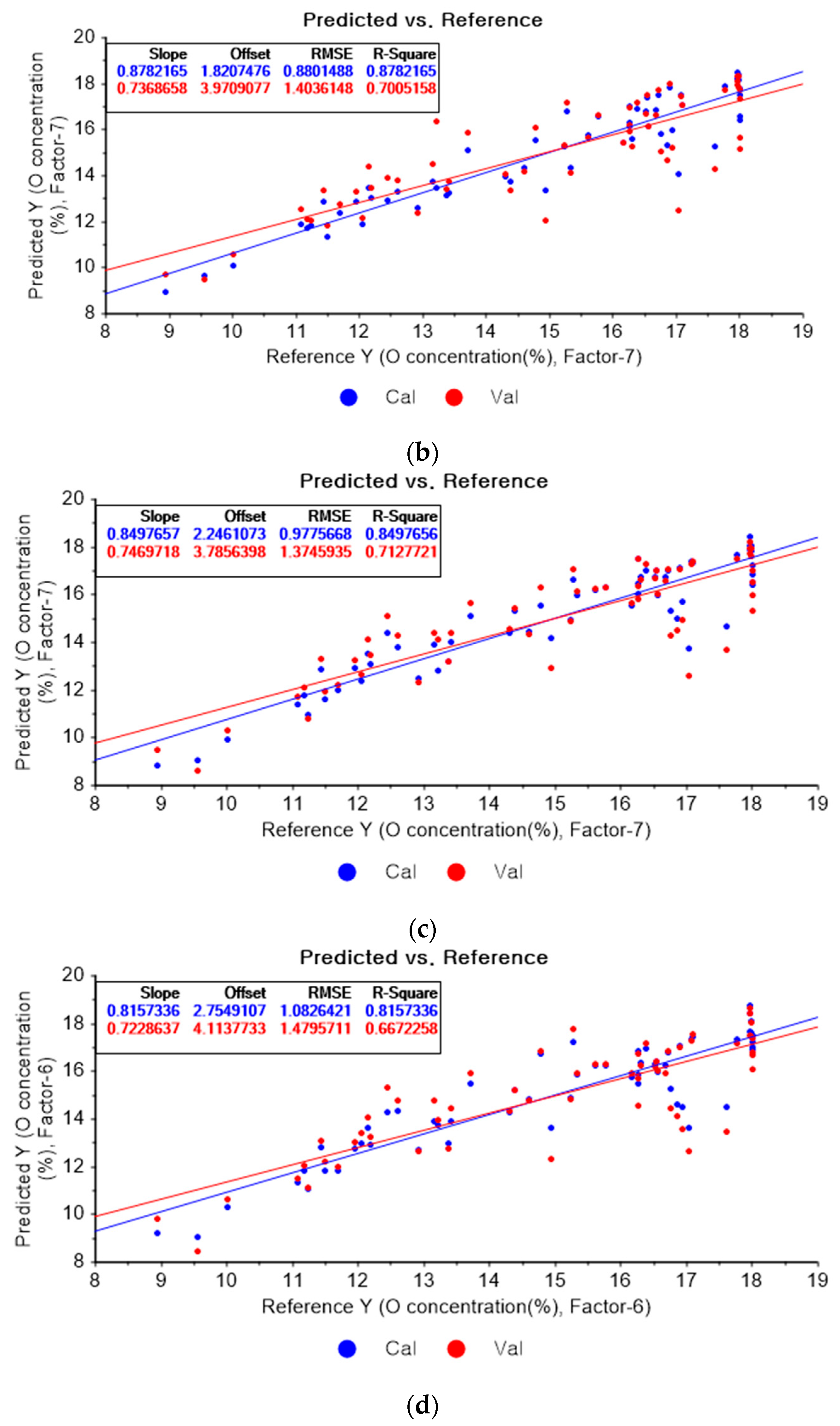
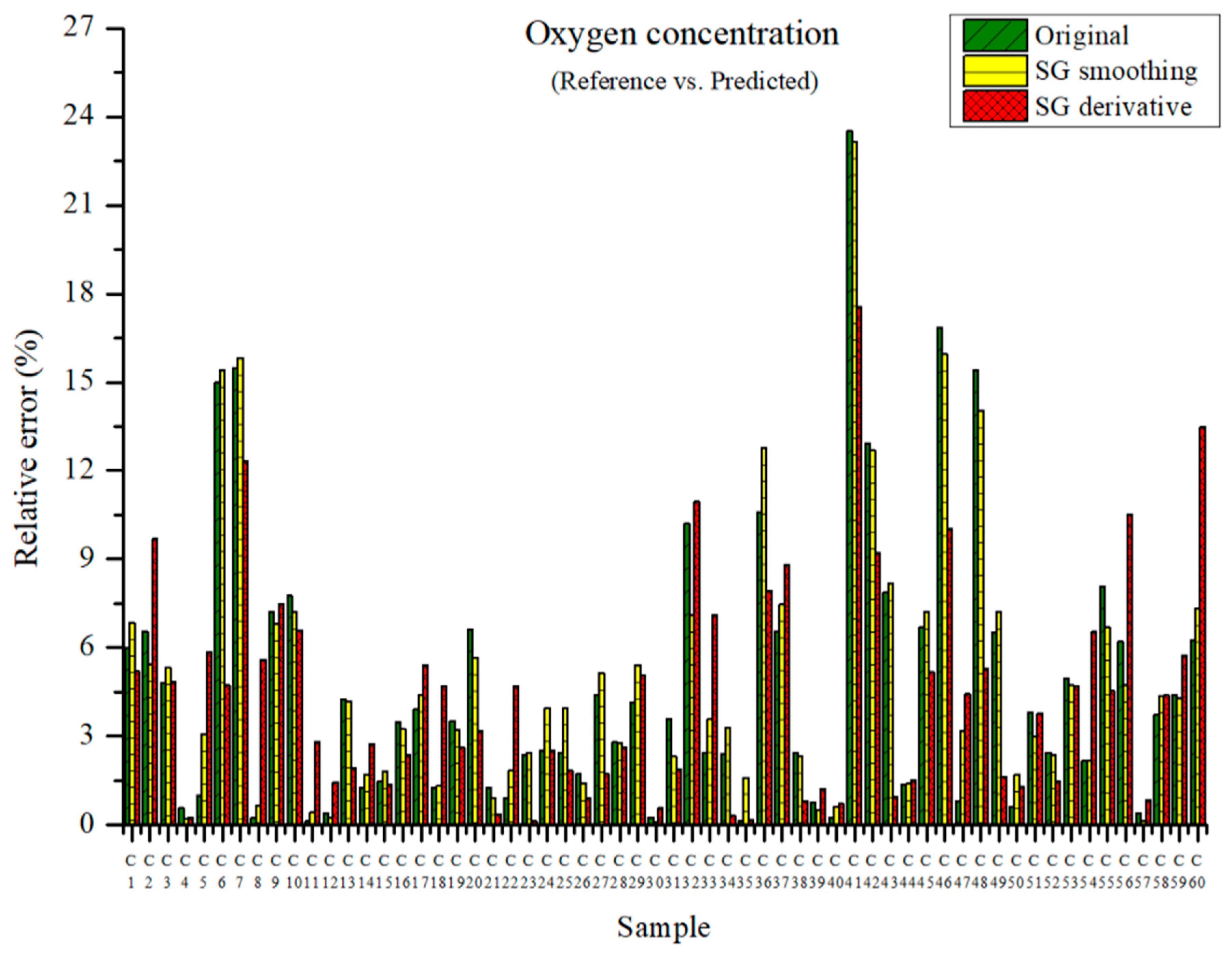
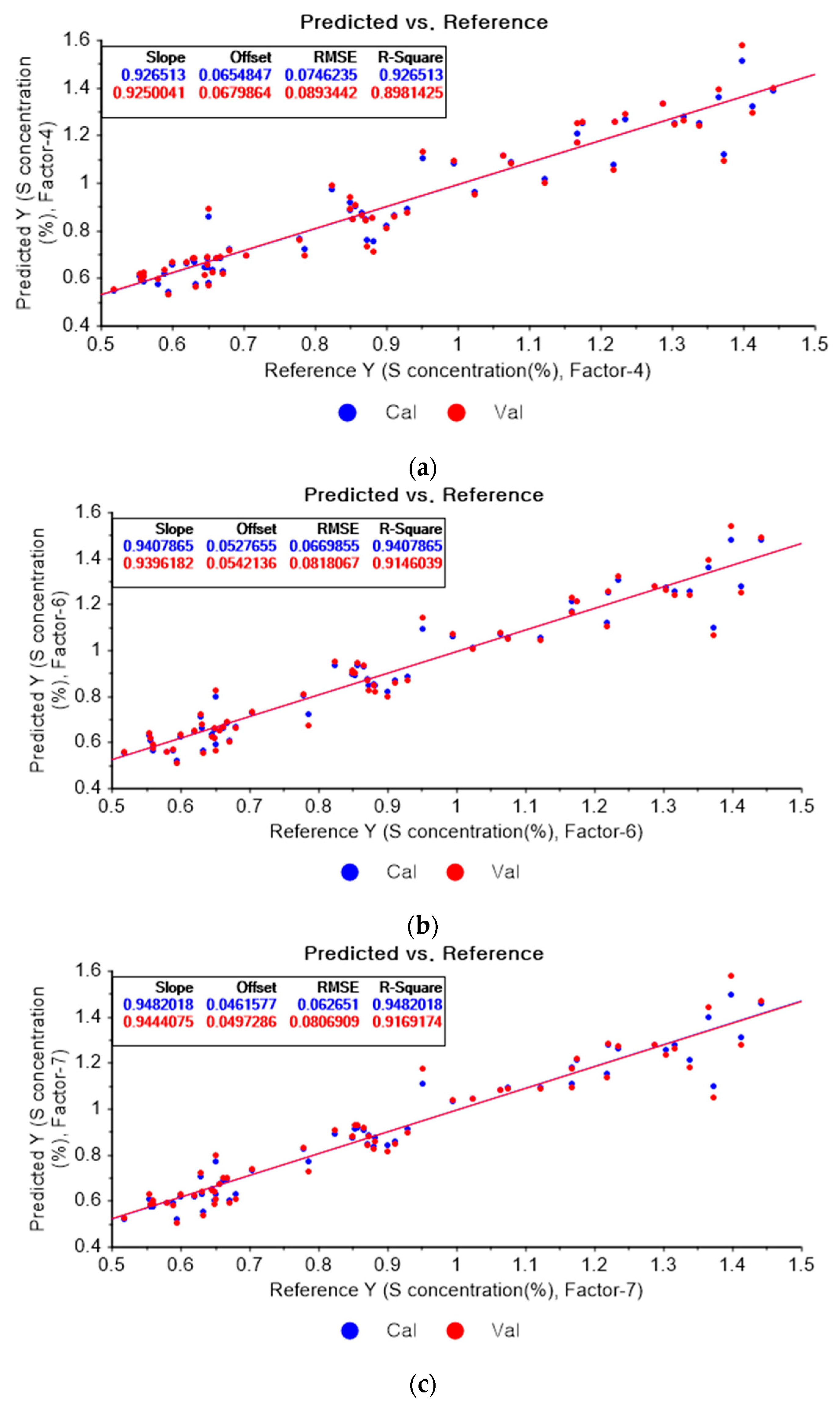
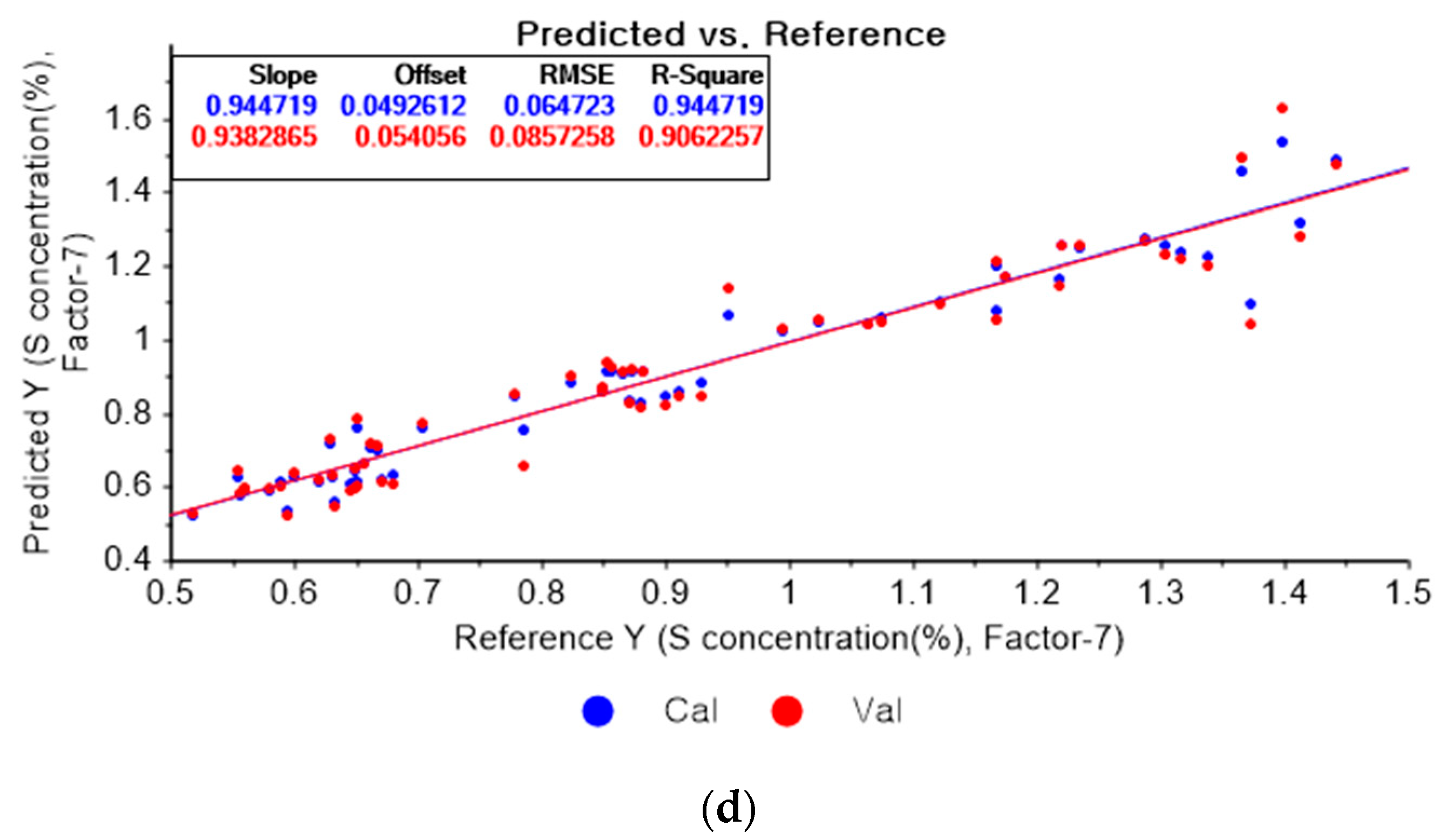
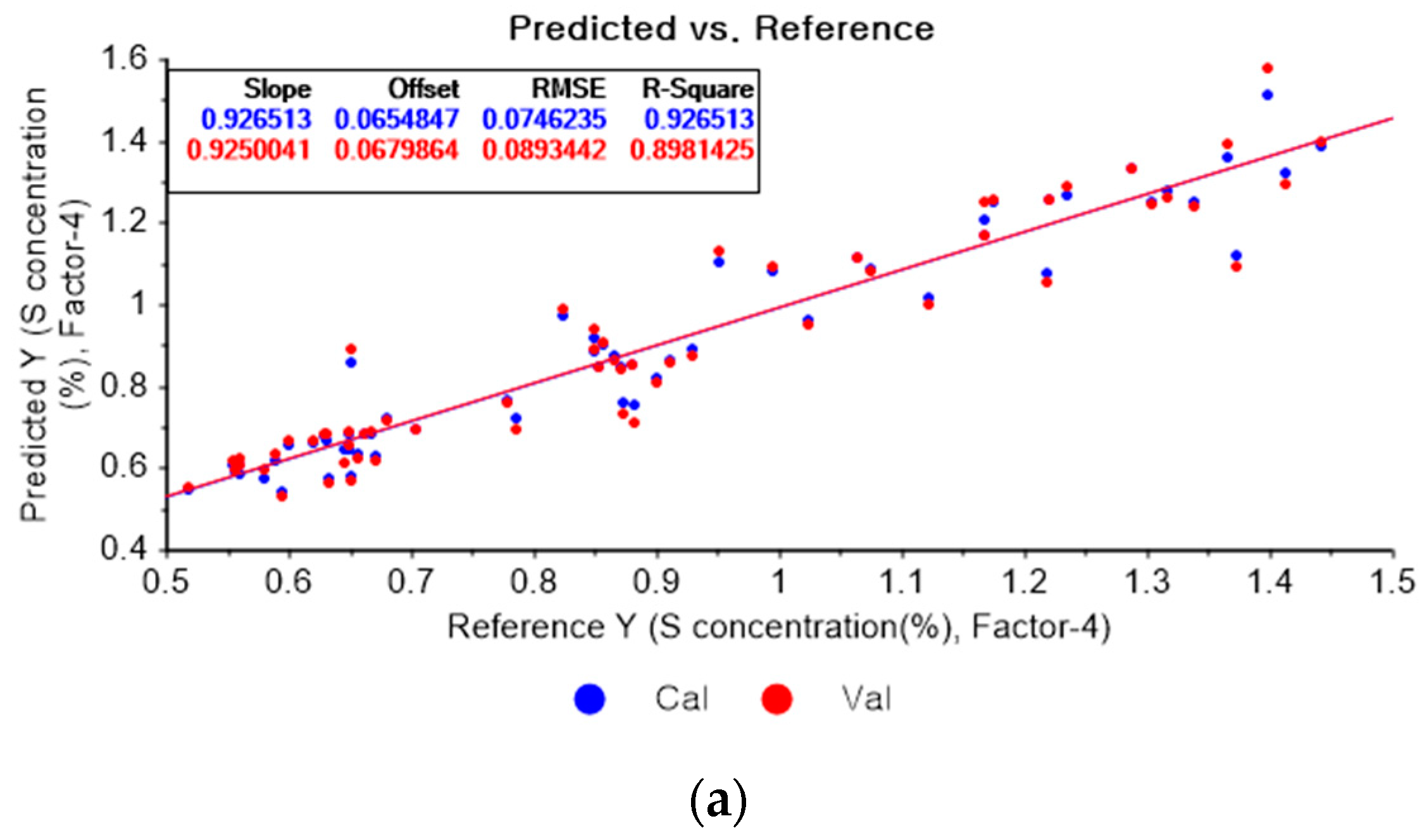
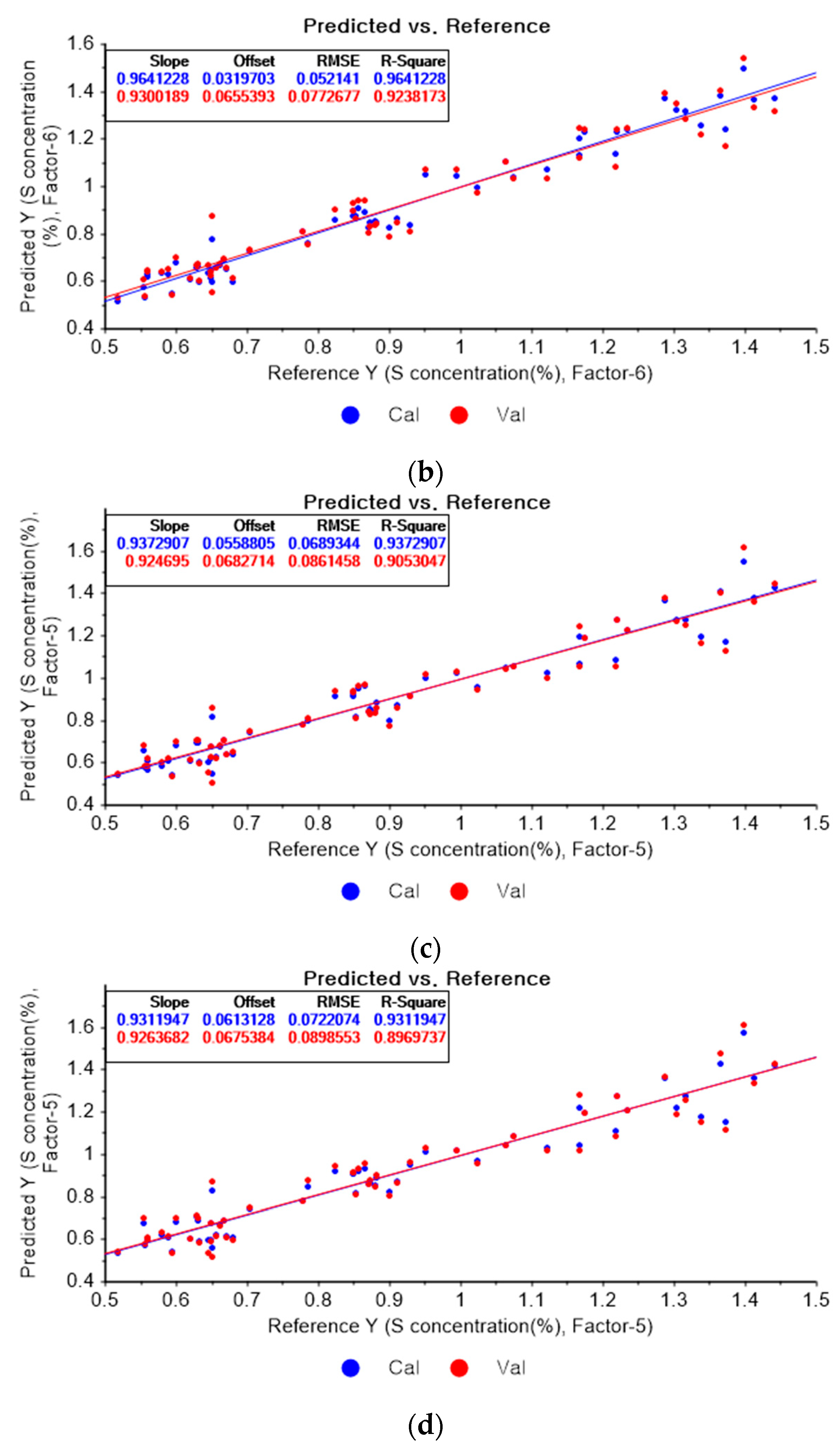
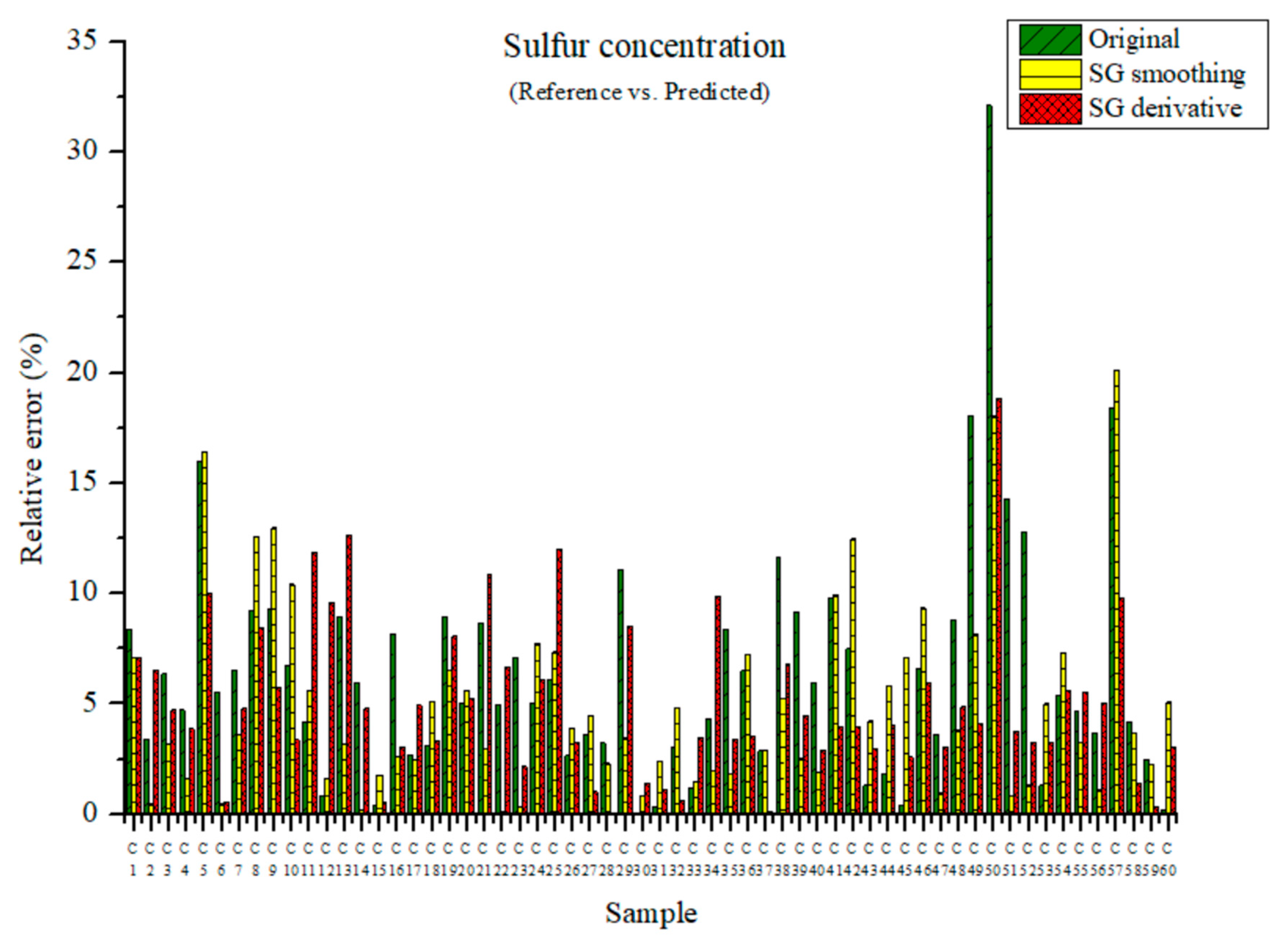
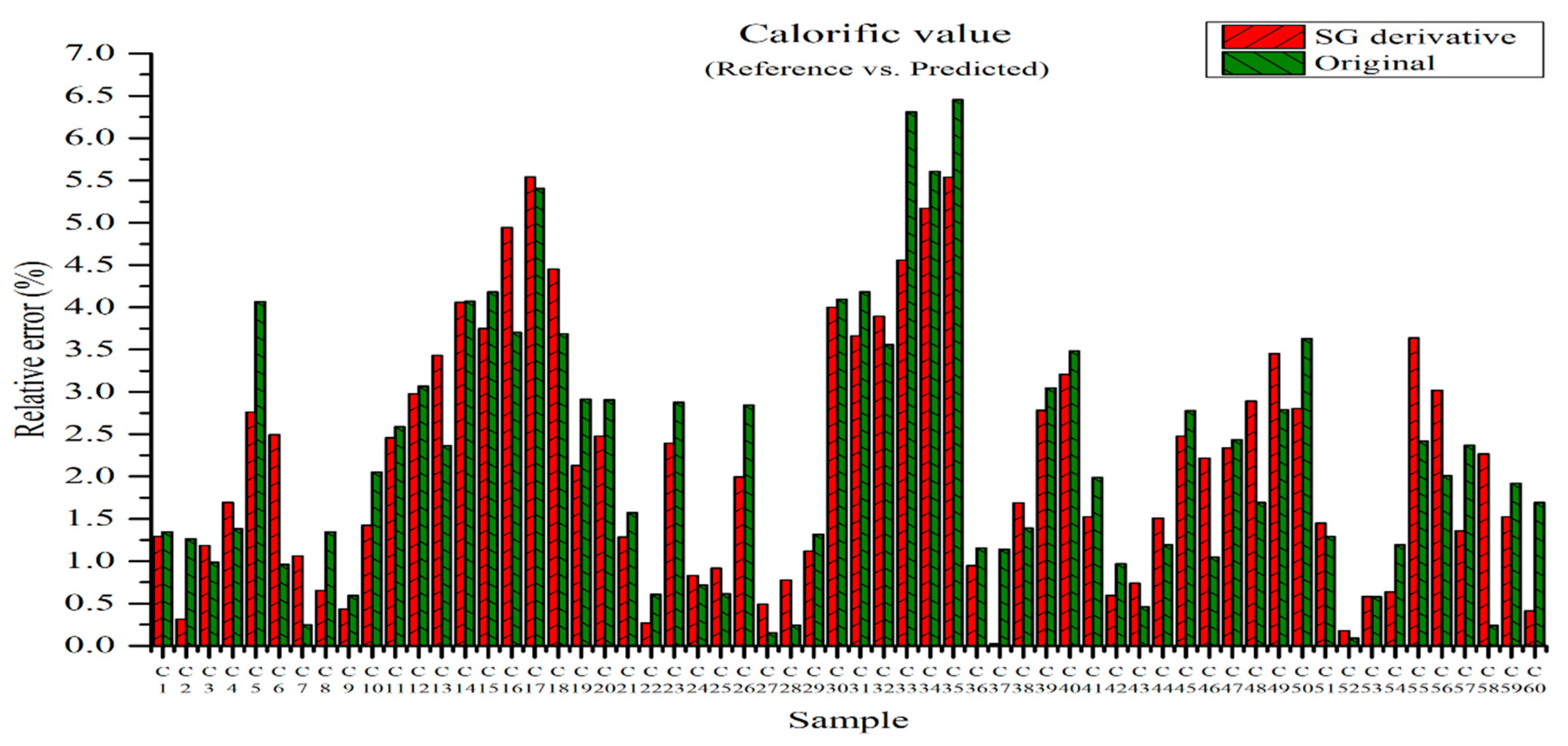
| Element | Data Pre-Processing | RMSEC(avg.) (%) | RMSECV(avg.) (%) |
|---|---|---|---|
| Carbon | Original data | 0.7570 | 0.9538 |
| SG smoothing | 0.7089 | 0.9080 | |
| SG derivative | 0.6792 | 0.9082 | |
| Hydrogen | Original data | 0.8652 | 1.3489 |
| SG smoothing | 0.8461 | 1.3914 | |
| SG derivative | 0.6258 | 1.0519 | |
| Oxygen | Original data | 6.7308 | 9.0414 |
| SG smoothing | 6.7563 | 9.0984 | |
| SG derivative | 5.8870 | 9.3883 | |
| Sulfur | Original data | 7.6019 | 9.1453 |
| SG smoothing | 7.5098 | 9.0301 | |
| SG derivative | 5.8513 | 8.6710 |
| Element | Data Pre-Processing | SD | RMSECV | RPD |
|---|---|---|---|---|
| Carbon | SG derivative | 2.16 | 0.69847 | 3.10 |
| Hydrogen | SG derivative | 0.14 | 0.05312 | 2.63 |
| Oxygen | SG derivative | 2.38 | 1.4031 | 1.70 |
| Sulfur | SG derivative | 0.27 | 0.07727 | 3.53 |
Disclaimer/Publisher’s Note: The statements, opinions and data contained in all publications are solely those of the individual author(s) and contributor(s) and not of MDPI and/or the editor(s). MDPI and/or the editor(s) disclaim responsibility for any injury to people or property resulting from any ideas, methods, instructions or products referred to in the content. |
© 2022 by the authors. Licensee MDPI, Basel, Switzerland. This article is an open access article distributed under the terms and conditions of the Creative Commons Attribution (CC BY) license (https://creativecommons.org/licenses/by/4.0/).
Share and Cite
Park, J.H.; Ryu, C.M.; Park, K.H.; Choi, J.H.; Moon, S.J. Determination of Calorific Value of Mixed Coals by Analysis of Major Elements Using Data Pre-Processing in Laser-Induced Breakdown Spectroscopy. Appl. Sci. 2023, 13, 6. https://doi.org/10.3390/app13010006
Park JH, Ryu CM, Park KH, Choi JH, Moon SJ. Determination of Calorific Value of Mixed Coals by Analysis of Major Elements Using Data Pre-Processing in Laser-Induced Breakdown Spectroscopy. Applied Sciences. 2023; 13(1):6. https://doi.org/10.3390/app13010006
Chicago/Turabian StylePark, Jong Hyun, Choong Mo Ryu, Kyung Hoon Park, Jung Hyun Choi, and Seung Jae Moon. 2023. "Determination of Calorific Value of Mixed Coals by Analysis of Major Elements Using Data Pre-Processing in Laser-Induced Breakdown Spectroscopy" Applied Sciences 13, no. 1: 6. https://doi.org/10.3390/app13010006
APA StylePark, J. H., Ryu, C. M., Park, K. H., Choi, J. H., & Moon, S. J. (2023). Determination of Calorific Value of Mixed Coals by Analysis of Major Elements Using Data Pre-Processing in Laser-Induced Breakdown Spectroscopy. Applied Sciences, 13(1), 6. https://doi.org/10.3390/app13010006







